By Kent Paterson
Momentous days riveted April in the southern New Mexico border communities of Sunland Park and neighboring Santa Teresa, where renewed controversy over water quality grips the public stage.
Dozens of people jammed the small Sunland Park City Council chambers April 5 in a town hall convened by City Councilor Alberto Jaramillo. Billed as the “Let’s Celebrate Our Hispano Heritage” event, the gathering heard city and utility company officials report on different municipal initiatives.
Befitting the small New Mexico city, the meeting was conducted in both Spanish and English, with some strenuous bouts of word searching over the translation of technical terms; some attendees insisted that Spanish should be used because that’s the language residents speak.
Flanked by Jaramillo, three other city officials and the interim head of the embattled local water utility, Sunland Park City Manager Mario Juarez-Infante Juarez informed the crowd about the pending relocation of the Motor Vehicle Department offices, neighborhood infrastructure projects, and immigration matters. He also discussed a possible land transfer from the Elephant Butte Irrigation District to the city, and a planned new Cannabis Fee Ordinance that is expected to be voted on by the City Council in May. If approved, the increased revenue will fund youth, fire and public safety services, Juarez-Infante explained.
For anyone who has visited Sunland Park lately, the proliferation of legal and flashy cannabis dispensaries is eye-grabbing. Mary Jane is stoking polemics, as several attendees at the town hall commented that their town is oversaturated with dispensaries and that the brisk marijuana sales, especially to El Paso residents, have not detonated much-needed new enterprises like grocery stores. A couple commented: “We do all our shopping in Texas” and “all our tax money is going to Texas.”
Prohibition regime-strapped Chuqueños who purchase legal pot across the tracks in Sunland Park might be happy to know that the dearth of essential businesses in the New Mexico municipality translates into a portion their money zipping straight back straight to the Sun City.
Other major projects in the works include a renewed push for the elusive U.S.-Mexico border crossing at Sunland Park, and a new highway that will ferry traffic from the existing one at Santa Teresa and cut through Sunland Park to semi-laden Interstate Ten.
The Burning, Slimy Water Question
But practically from the beginning of the meeting, a restless crowd clamored for information about what most people in attendance wanted to know more about: Sunland Park’s latest water woes and the crisis swirling around the Camino Real Regional Utility Authority (CRRUA), the public water utility which services both low-income Sunland Park and neighboring, upscale Santa Teresa, as well as the burgeoning industrial area on the adjacent border mesa which is an increasingly key nexus in U.S.-Mexico commerce.
According to CRRUA, an estimated 7,900 meters are connected to the utility, with that number anticipated to grow by an additional 6,500 homes in five years. Currently, CRRUA counts on five administrative staff and 7 operational staff to manage a sprawling and growing service area. According to Doña Ana County Assistant Manager Deborah Weir, the utility currently has about a dozen job openings.
Yet far from the first time, CRRUA is in trouble again with New Mexico state environmental authorities who last month slapped the water utility with a $251,580 fine for continued water law violations involving arsenic and notification failures. According to the state agency, CRRUA appealed the monetary penalty.
Also in March, the New Mexico Environment Department (NMED) sought help from the New Mexico State Attorney General and New Mexico State Auditor in probing CRRUA for potential violations of consumer protection law as well as the fraudulent or misuse of state and federal funds.
The most recent brouhaha surrounding CRRUA erupted last November after residents in Santa Teresa reported getting doses of “slimy water.”
Residents of the Valencia Park neighborhood of Santa Teresa, Mark and Lia Alonzo had been increasingly concerned about their CRRUA water since 2022, when the couple returned back to the borderland after living in Colorado and purchased what they considered their dream home in Valencia Park. “After the pandemic we wanted to move back and be closer to family,” said Lia, who works as an online physical fitness instructor while husband Mark is employed as a contract software engineer.
Yet instead of the peace and tranquility the Alonzos were desiring, the couple was soon suffering a raft of skin and eye ailments they variously suspected on pollen counts, non-acclimation to a new environment, or bad water. Alarm bells went off when tests performed by a private water filtration company indicated very high levels of arsenic might be present in the home water supply.
Then on November 27, 2023, the couple noticed something very wrong with the feel of their water. “I was taking a bath. I was sliding around in there,” Lia recalled. “Neither one of us could sit up.” Next day, a message appeared on the Valencia Park community Facebook page, asking if anyone “felt the water slimy?” The message also was circulated on a popular El Paso Instagram social media site. In reply, “hundreds” of messages responded like “wildfire,” with people describing foul tasting and slimy water, bouts of nausea, sick dogs, and more.
According to Lia, CRRUA was inundated with calls from customers for the next three days. At first, the company intermittently picked up calls, but the line soon went unanswered and no voice mail was activated for messages, she recollected. Frustrated, the Santa Teresa resident said she called the Sunland Park city government, but was told by a female clerk that the affair was the business of CRRUA and that she had not heard about water quality problems.
Finally, on December 1, affected residents received an official notice from the Doña Ana County, government, advising them “NOT to use the water coming out of the faucets for drinking, washing dishes, or bathing.”
Blaming the reports of “bitter water conditions” on a malfunctioning pump that caused increased pH levels, the advisory covered 7 neighborhoods in Santa Teresa and Sunland Park. What’s more, the Santa Teresa Industrial area was also impacted by the pH problem. On December 1, CRRUA informed NMED for the first time about the pH issue, according to the state agency. The next day NMED investigated and subsequently slapped CRRUA with a violation for failing to notify the public in the legally prescribed time.
CRRUA gradually restored service to the affected areas between December 3 and 6, and distributed free bottled water to residents for the first few days.
Yet similar problems of “discolored water” cropped up in Sunland Park’s Riverside neighborhood in February. “We all deserve just drinkable, safe water, a God-given right. Honestly, you shouldn’t be scared to touch your water,” Lia Alonzo asserted. “I regret moving back. You shouldn’t have to do water tests to live somewhere . . . this is supposed to be our forever home, and we’re sad. We’re just hoping we don’t get cancer.”
She added, “We shouldn’t be billed for this water at the very least. But how do they run their operation without money?” According to Sunland Park City Councilor Alberto Jaramillo, residents will receive credit on their bills for the water service interruption.
As the water crisis deepened, CRRUA Executive Director Brent Westmoreland, who assumed the position only months before a similar CRRUA water crisis unfolded in 2016, was suddenly history and a new interim executive director, Juan Carlos Crosby, took the helm.
Meantime, NMED personnel completed a sanitary survey of CRRUA, which cited dozens of deficiencies, the board tasked with overseeing CRRUA was reshuffled, and talk of lawsuits buzzed the burg. Former Sunland Park City Councilor Ken Giove, who also served on the CRRUA board during the 2016 arsenic affair, wasn’t too surprised at the latest developments.
A 17-year resident of the New Mexico border community, Giove, described CRRUA during his time on the board as practically operating in the dark without competent management. “This has gone on forever. The water was bad when we moved here and it’s still bad now.”
For his part, Democratic Congressman Gabriel Vasquez, whose district encompasses Sunland Park and Santa Teresa, denounced “systemic failure’ at CRRUA, pledging to stay abreast of the issue.
After years – even decades – of water woes it’s not shocking to hear that many people in Sunland Park and Santa Teresa say they do not drink the water that flows from their taps. Instead, they routinely dig into their pockets to buy bottled water.
To prove the point, Sunland Park resident Teresa Rodríguez showed up at the April 5 Town Hall with a glass jar containing a colored liquid substance she said was CRRUA water that “you can’t bathe in or drink.”
“It looks like beer,” Rodríguez quipped. No official at the meeting took up challenges to drink the water.
CRRUA Interim Executive Director Crosby was the man on the hot seat at the town hall. Crosby said NMED’s interventions underscored the need to improve employee training and hiring certified water operators, which he said are difficult to find.
“It’s an issue not only taking place in New Mexico. It’s taking place across the country,” Crosby said of the workforce shortage.
Crosby confirmed that CRRUA’s arsenic treatment system wasn’t working when he came on board in January, but as of March 18, all four arsenic treatment facilities were performing below the permissible EPA standards, he said. He later told the elected Dona Ana County Board of Commissioners that the arsenic treatment system was down for more than a year.
“Just because the arsenic treatment plants are operational, we still have a way to go. We have additional upgrades that are required to bring the arsenic treatment facilities to perform at their optimal level,” he added. Consequently, the CRRUA board approved an “emergency order” to purchase specialized equipment for the treatment system which requires a lead time of 11-14 weeks to obtain.
Crosby attributed the matter of discolored water to waterline breaks, flushings of hydrants, malfunctions in the pumping of water from well to tank, and periodic high demands that will “agitate and stir up the mineral deposits and cause a discoloration of the water.”
In Sunland Park, Crosby’s presentation was peppered with comments and questions from the audience, which came to an abrupt end when Crosby broke of his talk and departed the premises. Judging from the mood of the crowd, many if not most people left unsatisfied with official explanations. Some residents demand the resignation of current CRRUA board members, stepped up oversight from the NMED and EPA, and even the criminal prosecution of responsible officials.
Daisy Maldonado, executive director of Doña Ana County’s Empowerment Congress, a non-profit organization active in community organizing, summed up the popular sentiment as she spoke with the reporter after the meeting:
“Water is a basic human right, and the fact that they don’t care to deliver safe and clean drinking water to the customers here is unconscionable.”
Attendee Jesús Vaquera called the town hall a “sham,” adding that he planned to attend the “real meeting,” the next CRRUA monthly board meeting which was originally scheduled for Monday, April 8. When informed by the reporter that the meeting had been cancelled, Vaquera voiced surprise. “Really?” he asked. “Another question: Why?”
The reporter posed Vaquera’s question to City Councilor and CRRUA board member Alberto Jaramillo immediately after the meeting. “Sometimes it’s because we don’t have an item on the agenda, and that’s simply because of that,” Jaramillo replied.
“And there wasn’t a pressing item on the agenda for Monday?” the reporter queried.
“There wasn’t any item, so that’s why the agenda canceled. It could be anything from a budget to anything else. That’s why it was canceled – no items.”
Regarding arsenic, Jaramillo also maintained that the levels were now safe and below the EPA exceedance threshold.
“I will tell people not to confide in me but confide in the numbers. If they want to look into the numbers, it’s public information,” Jaramillo said. “They can always look into the actual data that’s out there, because there’s people who will take advantage of the situation selling filters and they’re going to come in, make people afraid. That’s going to cause a chaos. That’s something that is happening right now.”
Terming Sunland Park’s residents “good people,” Jaramillo said he will organize other town halls dedicated to community concerns.
The current edition of the Spanish language Camino Real newspaper published and distributed in the Paso del Norte borderland features two full pages from CRRUA that provides a checklist of the NMED-identified deficiencies cited in the sanitary survey conducted late last year.
Of the 58 published deficiencies, CRRUA claimed 56 percent were resolved as of March 26, including bringing arsenic treatment to below the federal standard of 0.010 mg/L (10ppb) for drinking water.
However, on March 15, NMED took a water sample from the Santa Teresa Industrial Area that tested above the federal arsenic standard; nine samples from Sunland Park sites tested below the standard.
More Begging Questions and Lingering Concerns
Four days after the Sunland Park town hall, Juan Carlos Crosby was again on the hot seat, this time at the Doña Ana County Board of County Commissioners meeting held April 9 in the county seat of Las Cruces.
Under a Joint Powers Agreement with the City of Sunland Park, the New Mexico border county is represented on CRRUA’s board. Indeed, current County Commissioners Diana Murillo and Susana Chaparro sit on CRRUA’s board; Commissioner Mark Sanchez served on the CRRUA board several years ago.
Acting as the fiscal agent for CRRUA, Doña Ana County is responsible for handling CRRUA’s grant funding, finances, Information Technology, and job application screenings.
Addressing the Board during the public comment session prior to Crosby’s scheduled presentation, the Empowerment Congress’ Daisy Maldonado said she had earlier planned to speak out at the regular CRRUA board meeting which was scheduled prior day, but couldn’t because it was canceled. Directing a comment to Murillo and Chaparro, Maldonado asked how staff will be held accountable for misleading the community about water quality.
There was no immediate response.
Crosby gave an almost verbatim report of his presentation at the Sunland Park town hall, ultimately, declaring, “I can safely say that the water is potable.” For the future, Crosby said CRRUA plans on doubling its staff, and is engaged in overseeing the implementation of approximately $21 million in capital improvements. But citing pending “litigation,” the CRRUA director stopped short of answering certain questions from the Commission.
As Crosby spoke, signs reading “We Want Safe Drinking Water” and “We are Paying for Water We Can’t Drink” decorated the front row behind the official. Several Sunland Park residents and supporters spoke after Crosby, reiterating community complaints and concerns voiced earlier on April 5.
The meeting, which devoted nearly 90 minutes to the CRRUA issue, grew testy at times. When Las Cruces attorney Israel Chávez told the commissioners that County Attorney Nelson Goodin shouldn’t “misinform” the Commission as is “typical,” Goodin erupted, yelling out, “Mr. Chair, I do not need to be attacked!” He then stormed out of his seat. An exchange between Commission Chair Christopher Schaljo-Hernandez and Chavez then ensued.
County Commission members spent considerable time questioning Crosby, variously querying and commenting about hiring, staffing and training, arsenic treatment, New Mexico environmental law violations, a pending CRRUA board revamping which will add new members with technical expertise, and squaring CRRUA’s present and planned infrastructure with the tremendous growth underway in Santa Teresa and Sunland Park. The commissioners reached a consensus that many of the burning matters would best be handled in a closed session held sometime very soon.
“There needs to be (public) confidence restored, and until that’s done it’s kind of no go, no stop for me that we need to figure this out,” Commission Chair Schaljo-Hernandez said. “So hopefully we get some assurance during that closed session that can start to help facilitate those conversations.”
Legacy and Possibility
On April 6, the Saturday before the April 9 Las Cruces meeting, a group of local residents braved a fiercely frigid spring wind for an outdoor meeting in Santa Teresa about the future of their water. Two representatives of the New Mexico Environmental Law Center (NMELC), Executive Director Dr. Virginia Necochea and staff attorney Kacey Hovden, spoke to the group about the importance of documenting personal experiences and interactions with CRRUA as well as the centrality of community participation.
“You guys take the lead and we support it,” Hovden said. The NMELC lawyer clarified that her organization didn’t intend on pursuing a lawsuit at this time, but was committed to engaging alongside the community in its struggle. “Our main goal is to make sure you have safe water,” she said.
Historically, the NMELC represented Sunland Park residents in a battle against the local landfill and a medical waste incinerator, which was shut down in the early 1990s after an intense community mobilization. Nonetheless, the landfill remained and is a sore point of contention to this day. The earlier environmental battle is regarded as one of the emblematic struggles of the environmental justice movement of low income and people of color that emerged in the United States during the 1980s and early 1990s.
Isabel Santos is one longtime resident of Sunland Park who takes a long and critical view of the current controversy. A leading activist of the old Concerned Citizens of Sunland Park organization which battled the medical waste incinerator and landfill, Santos later served on the Sunland Park City Council and as Mayor Pro-Tem. She showed up for the April 5 town hall lugging old newspaper clippings chronicling environmental troubles back to the early 1990s, including high levels of lead and worms in the water.
“Since 1992 when we announced that, the people began to buy gallons of water, which they do until now,” Santos said. “Now that’s happening in Santa Teresa, in the rich homes, they are paying attention. But we have many years with water problems. We have the evidence, all of that. And they never paid attention to us.”
In 2024, Santos and other Sunland Park and Santa Teresa residents are waiting for the next shoe to drop in this long saga of water, politics and environmental justice.
For more background on the Sunland Park-Santa Teresa water quality issue check out:
Doña Ana County Board of County Commissioners meeting, April 9, 2024

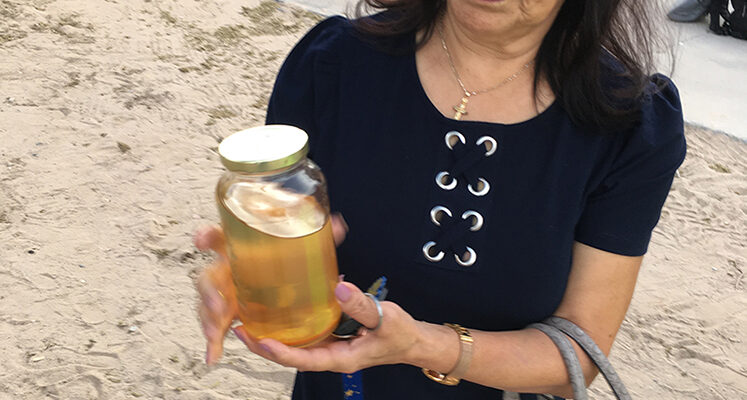

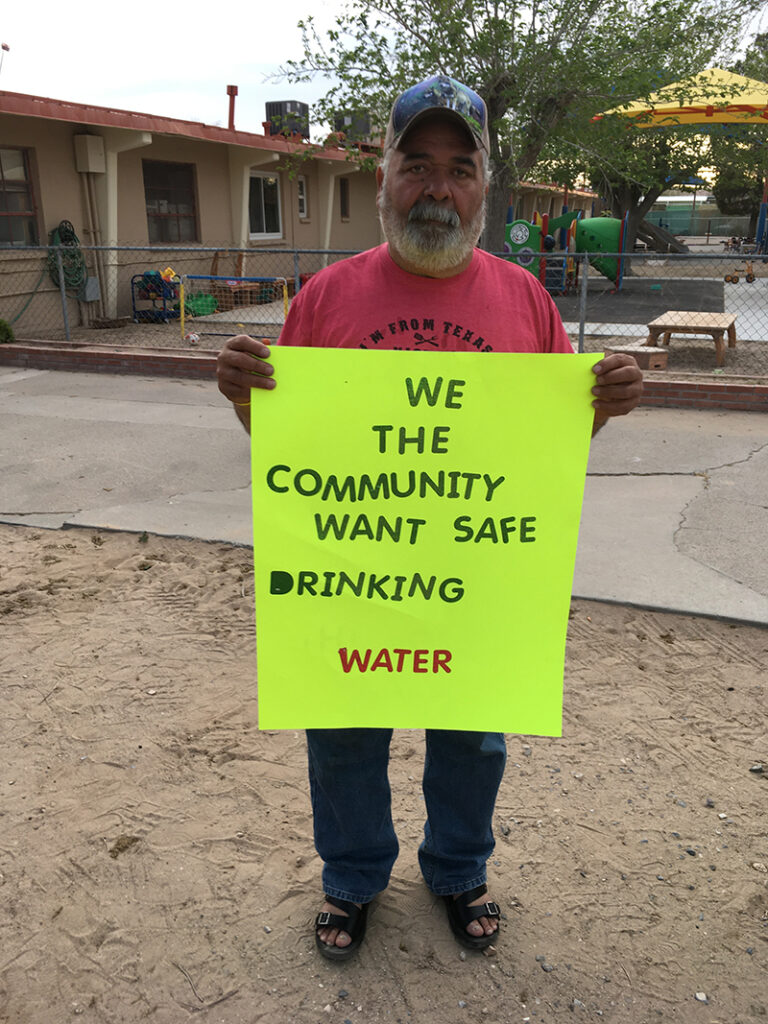
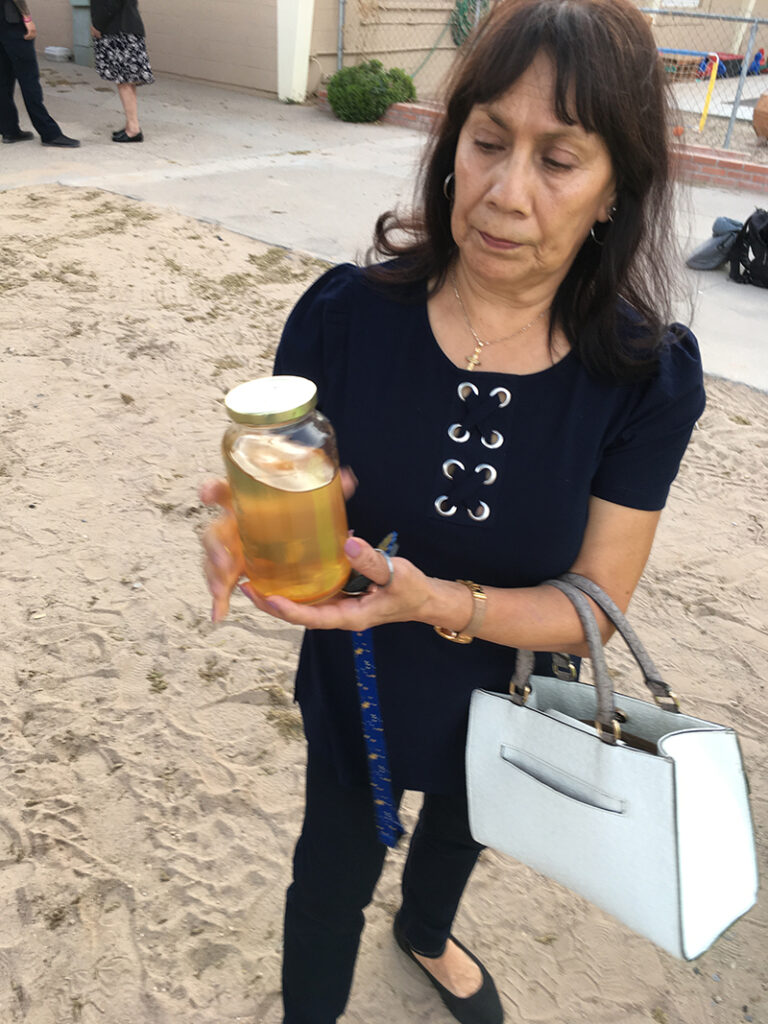
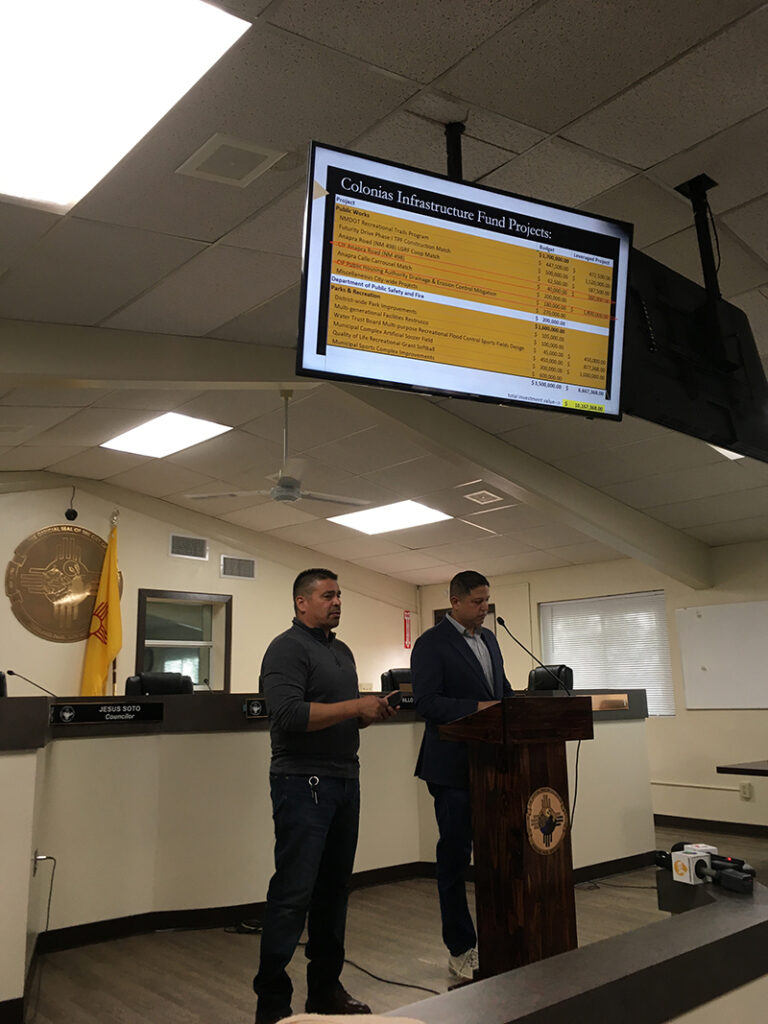
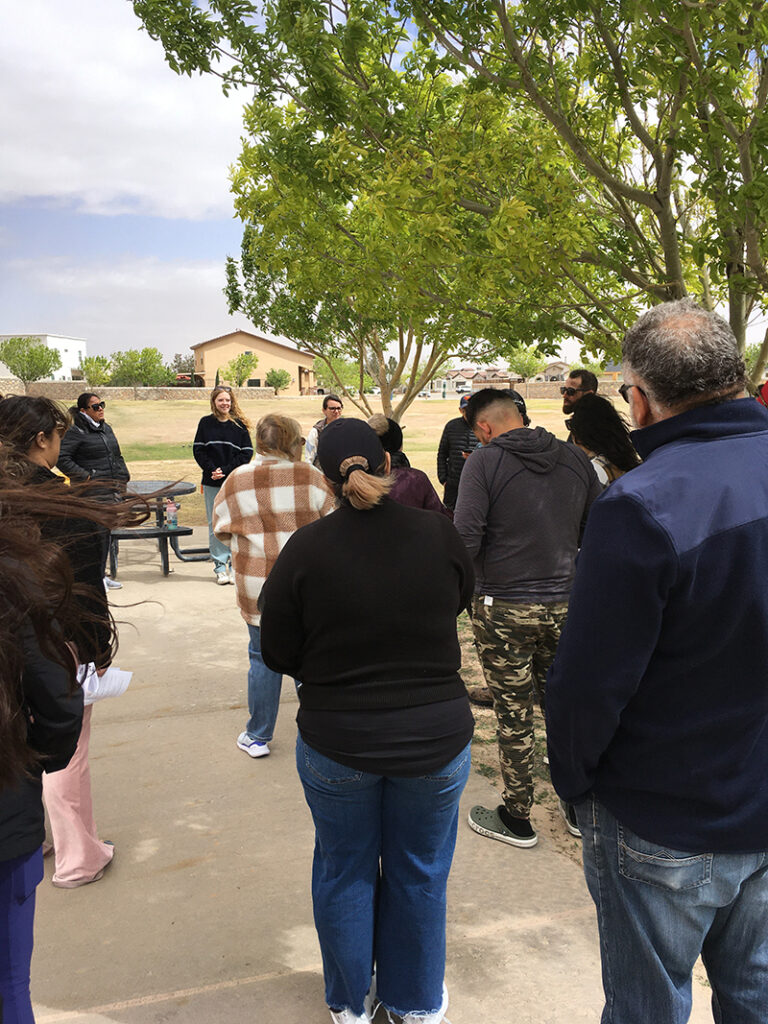
“…emblematic struggles of the environmental justice movement of low income and people of color…”
These are real issues and not limited just to Sunland Park that looks to me to be more a matter of managerial incompetence than injustice. But I do not see where the state fining them helps at all. The state should probably take over the CRRUA.
We have these issues here, too, fortunately not water-related yet. The Bridge of the Americas (BOTA) is probably the most egregious example of environmental injustice. It was built long before NAFTA crowded its lanes with idling diesel trucks fumigating the poorer neighborhoods in the vicinity, even school playgrounds. The City would not even discuss an agenda item to write a letter to the GSA (that will design and build the new PoE on the US side) asking the GSA to consider banning commercial truck traffic from the PoE.
When it comes to making money – the maquiladora industry and the warehouse parks here – no one cares about the poor.
Well Jerry K, forever chemicals are very present in our water. Another Flint, MI situation! They all know! And continue to profit on us!